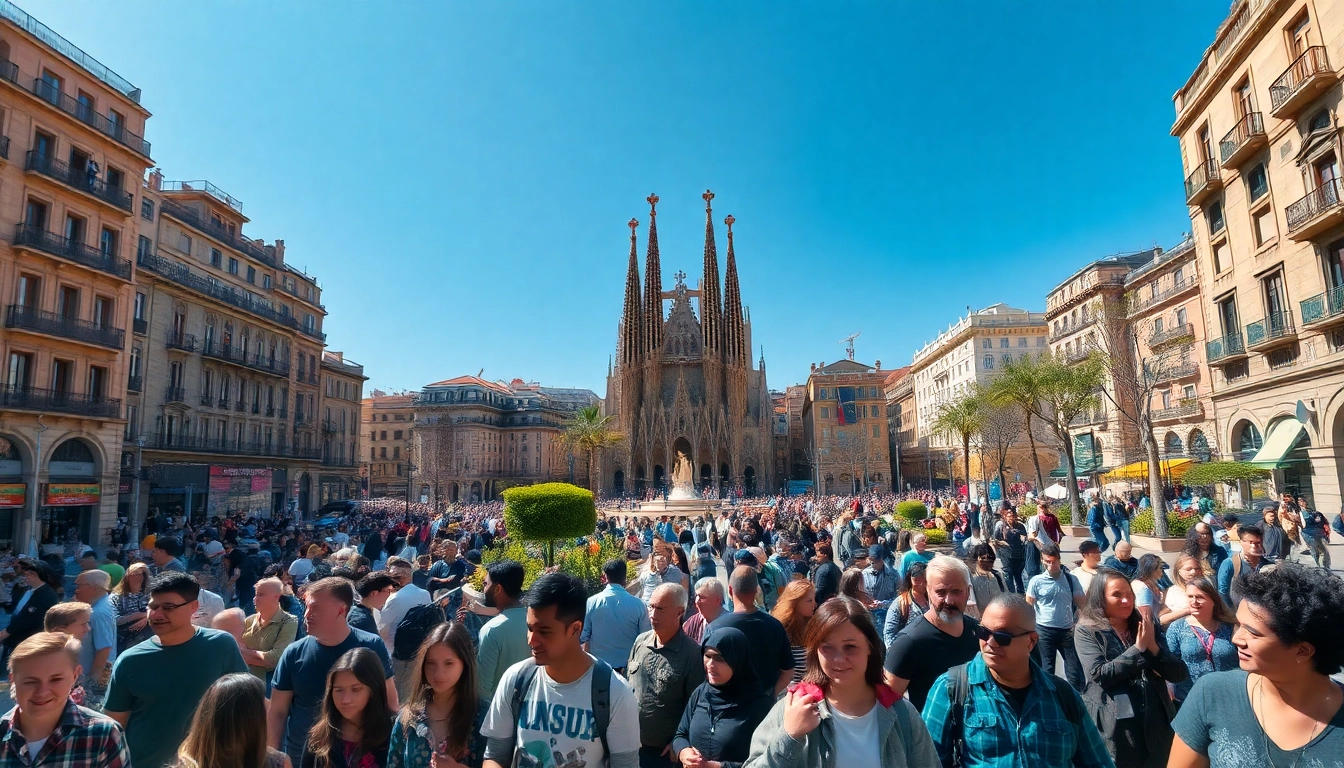Overview of Barcelona Population Trends
Barcelona, the vibrant capital of Catalonia and the second-largest city in Spain, is known for its rich history, unique architecture, and dynamic cultural scene. As of recent estimates, the barcelona population stands at approximately 1.73 million within the city limits, with projections indicating significant growth in the coming years. This article delves into the intricacies of Barcelona’s demographic landscape, historical growth patterns, and factors influencing its population trends.
Current Population Statistics
Barcelona’s current population is a testament to its status as a global city. The city has seen fluctuations over the years, with the resident population recently surpassing 1.73 million. The urban area, which includes surrounding municipalities, boasts a significantly larger population, estimated at around 5.7 million. Such numbers reflect Barcelona’s attractiveness as a place to live, work, and study, drawing both nationals and expatriates.
Population density is another critical aspect, with approximately 15,992 residents per square kilometer, which presents both opportunities and challenges in urban management and planning. The city’s demographics also reflect a mosaic of cultures, with a sizeable percentage of foreign nationals contributing to the city’s social fabric.
Demographic Breakdown
The demographic profile of Barcelona is diverse, influenced by various waves of immigration over the decades. Approximately 17.6% of the population consists of non-nationals, indicating a multicultural society where nearly 20.7% of inhabitants are foreign-born. This diversity enriches the city’s cultural landscape and embodies a blend of traditions, languages, and lifestyles. Among the most prevalent communities are those from Latin America, Europe, and Asia, who have come to Barcelona for various reasons, including employment, education, and improving quality of life.
Age distribution patterns further illustrate the dynamic population. The younger population constitutes a substantial portion, with a significant percentage under 30, while the elderly demographic is gradually increasing, resulting in a growing need for tailored healthcare and social services.
Historical Growth Patterns
The history of Barcelona’s population growth is characterized by notable periods of increase, influenced by historical events, economic factors, and urban development. In the post-World War II era, Spain witnessed dramatic urbanization, with Barcelona emerging as a hub for industry and services. This migration of people seeking employment led to rapid population increases, peaking in the late 20th century.
Despite experiencing economic downturns, the population continued to grow, driven by the city’s robust economy, cultural attractions, and educational institutions. The recent influx of international migrants has also played a crucial role in shaping this trend, contributing to a more diverse and dynamic urban community.
Factors Influencing Population Growth
The population dynamics of Barcelona are influenced by multiple interrelated factors which include migration trends, economic opportunities, and future growth projections. Understanding these elements can provide insights into urban planning and policy-making frameworks aimed at creating sustainable communities.
Migration Trends and Influences
Migration is arguably one of the primary catalysts of population growth in Barcelona. People from different regions migrate to the city for various reasons, including employment opportunities, quality education, and favorable living conditions. The city’s reputation as a cultural and financial center attracts individuals seeking better prospects.
Moreover, the rise of remote work, especially post-pandemic, has enabled many to relocate to Barcelona while maintaining their employment from different geographic locations. This trend encourages expatriates, including highly skilled professionals and digital nomads, to settle in the city, further enriching its socio-economic landscape.
The local government has also implemented various integration policies to facilitate the smooth transition of immigrants into the society, promoting multicultural interaction and social cohesion.
Economic Factors and Employment Opportunities
Barcelona’s buoyant economy plays a significant role in bolstering its population growth. With a strong presence in sectors such as tourism, technology, and international trade, job creations in diverse fields attract both locals and newcomers. The technology sector is witnessing particularly rapid growth, thanks to an increasing number of startups and innovation hubs situated in the city.
The local economy’s resilience is indicative of positive employment trends, offering a wide range of job opportunities at various skill levels. As companies increasingly seek talent, investment in education and skill development is crucial for maintaining this upward trajectory, ensuring that residents are equipped to meet evolving market demands. Furthermore, economic stability influences internal migration from other parts of Spain, further contributing to the population increase.
Plausible Future Growth Projections
Projections for Barcelona’s population indicate sustained growth, with estimates suggesting that the barcelona population could reach approximately 5.7 million in the metropolitan area by the next decade. Such projections are based on current demographic trends, increased immigration, and economic expansion. The ongoing development of infrastructure and urban planning initiatives aimed at accommodating this growth plays a pivotal role in shaping a sustainable future for the city.
However, these projections must be approached cautiously. Urban planners and local authorities need to balance growth with the provision of essential services such as healthcare, education, and transportation infrastructure. This holistic approach will not only ensure enhanced living conditions but also foster a sustainable environment for all residents.
Impact of Population on Urban Development
The implications of a growing population in Barcelona extend beyond mere numbers; they present significant challenges and opportunities for urban development, infrastructure, and quality of life for inhabitants.
Infrastructure and Transportation Needs
As the population increases, so do the demands on infrastructure and transportation networks. The city has implemented various measures to address the mobility needs of its residents, including an extensive public transport system consisting of buses, trams, and the metro. Enhancing these networks is essential to reduce congestion and improve accessibility.
Barcelona has also embraced sustainable urban mobility solutions, encouraging walking and cycling as healthier alternatives. The introduction of bike-sharing programs and pedestrian-friendly urban spaces reflects the city’s commitment to fostering a sustainable urban environment. However, with population density increasing, continuous investment in transportation infrastructure is necessary to ensure long-term resilience.
Housing and Real Estate Trends
The demand for housing in Barcelona has surged as the city continues to attract new residents. Consequently, the real estate market has seen various trends, including rising property prices and developments in housing solutions. Gentrification in certain neighborhoods has raised concerns over affordability and displacement.
To combat these challenges, the local government is promoting policies aimed at increasing affordable housing options while preserving controlled rental prices within key areas. Furthermore, urban renewal projects are being initiated to repurpose older buildings and improve living standards, ensuring that housing remains accessible to diverse income levels.
Urban Planning Challenges
Urban planning in a densely populated city like Barcelona comes with unique challenges. A rapidly growing population necessitates strategic planning to accommodate new developments while preserving the city’s cultural heritage and environment. Balancing the demands for housing, green spaces, and community amenities requires careful consideration and collaboration among stakeholders.
Additionally, climate change presents further complications for urban planners. Preparing the city to withstand extreme weather events and rising sea levels is essential for safeguarding the wellbeing of residents. Sustainable planning initiatives focused on reducing energy consumption, increasing green spaces, and enhancing resilience are steps towards ensuring that Barcelona remains a livable city well into the future.
Social and Cultural Aspects of the Barcelona Population
The rich tapestry of Barcelona’s population is not solely defined by demographics; it encompasses diverse social and cultural aspects that contribute to the city’s identity. Understanding these aspects is crucial for fostering community engagement, cultural exchange, and social cohesion.
Diversity and Multiculturalism
Barcelona is a beacon of diversity, home to a myriad of cultures and nationalities. This multicultural environment enhances the city’s vibrancy and innovation, fostering a rich tapestry of experiences and traditions. Festivals, cultural events, and culinary diversity reflect the fusion of influences that define Barcelona.
Integration policies aimed at fostering unity among different communities focus on promoting dialogue, mutual respect, and social integration. Community initiatives often celebrate diversity through arts and cultural programs, allowing residents to share their heritage while learning from others.
Community Initiatives and Integration Programs
Community-driven initiatives play a vital role in creating an inclusive society. Various organizations and local governments implement programs designed to support immigrants and marginalized groups, helping new residents adapt to their environments. Language courses, employment assistance, and cultural exchange programs are essential components of these initiatives.
Additionally, social cohesion efforts work to reduce barriers among communities, encouraging mutual understanding and respect across different cultural backgrounds. Such programs not only benefit newcomers but also enhance the overall quality of life for existing residents, strengthening the social fabric of Barcelona.
Cultural Festivals and Events Celebrating Diversity
Cultural festivals in Barcelona provide an opportunity to celebrate the city’s diversity and rich heritage. Events like La Mercè and Festes de Gràcia draw residents and visitors alike to revel in the many colors, sounds, and tastes of the city. These celebrations showcase local traditions while integrating influences from various cultures, fostering a sense of unity and mutual appreciation.
Moreover, art exhibitions, music festivals, and culinary fairs contribute to the city’s cultural landscape, encouraging creative expression and cultural exchange. Such events not only enhance community ties but also position Barcelona as a global cultural hub, attracting tourists and artists worldwide.
Comparative Analysis of Barcelona Population
Understanding the demographics of Barcelona requires a comparative lens, taking into account its standing relative to other major Spanish cities and worldwide urban population trends. This analysis provides contextual insights into its challenges and opportunities.
Barcelona vs. Other Major Spanish Cities
When compared to other major cities in Spain, such as Madrid and Valencia, Barcelona stands out for its unique blend of culture and lifestyle. Although Madrid has a larger population, with around 3.2 million residents, Barcelona’s population density and urban vibrancy create distinctive living experiences. Valencia, with a population of approximately 800,000, offers insights into different urban management strategies and economic dynamics.
Barcelona’s ability to attract international migrants gives it an advantage in cultural diversity, innovation, and economic growth. This comparative analysis highlights the need for effective urban policies to leverage Barcelona’s strengths while addressing the challenges posed by its dense population.
Insights from Global Urban Population Trends
Barcelona’s population dynamics mirror trends observed in global cities: increasing urbanization, multiculturalism, and the impact of global mobility. Similar to cities like New York, London, and Tokyo, Barcelona faces the dual challenge of accommodating growth while maintaining livable conditions for residents.
Urban planners and policymakers can glean valuable lessons from these cities, particularly regarding sustainable development practices, smart housing initiatives, and transit-oriented growth. By studying successful case studies, Barcelona can adopt innovative strategies to manage population growth while enhancing residents’ quality of life.
Lessons Learned from Other Metropolitan Areas
Analyzing the population challenges faced by other metropolitan areas worldwide, including issues of housing affordability, transportation accessibility, and social integration, offers crucial lessons for Barcelona. Continuous dialogue with successful metropolitan strategies enables Barcelona to position itself as a leading urban center while preparing to tackle impending challenges.
Sustainability initiatives involving green building practices, eco-friendly transport solutions, and community engagement provide pathways for enhancing resilience without sacrificing growth. Hence, the collaborative transfer of knowledge from global counterparts is essential for fostering a thriving urban environment in Barcelona.
In summary, the barcelona population landscape reflects a dynamic, evolving city on the cusp of substantial growth. Understanding its demographic intricacies, factors influencing population change, and social implications lays the groundwork for future development strategies aimed at maintaining Barcelona’s unique character and vibrant community life. Through focused policy initiatives, enhanced urban planning, and engagement with diverse communities, Barcelona is well-positioned to navigate its future as a global city.


